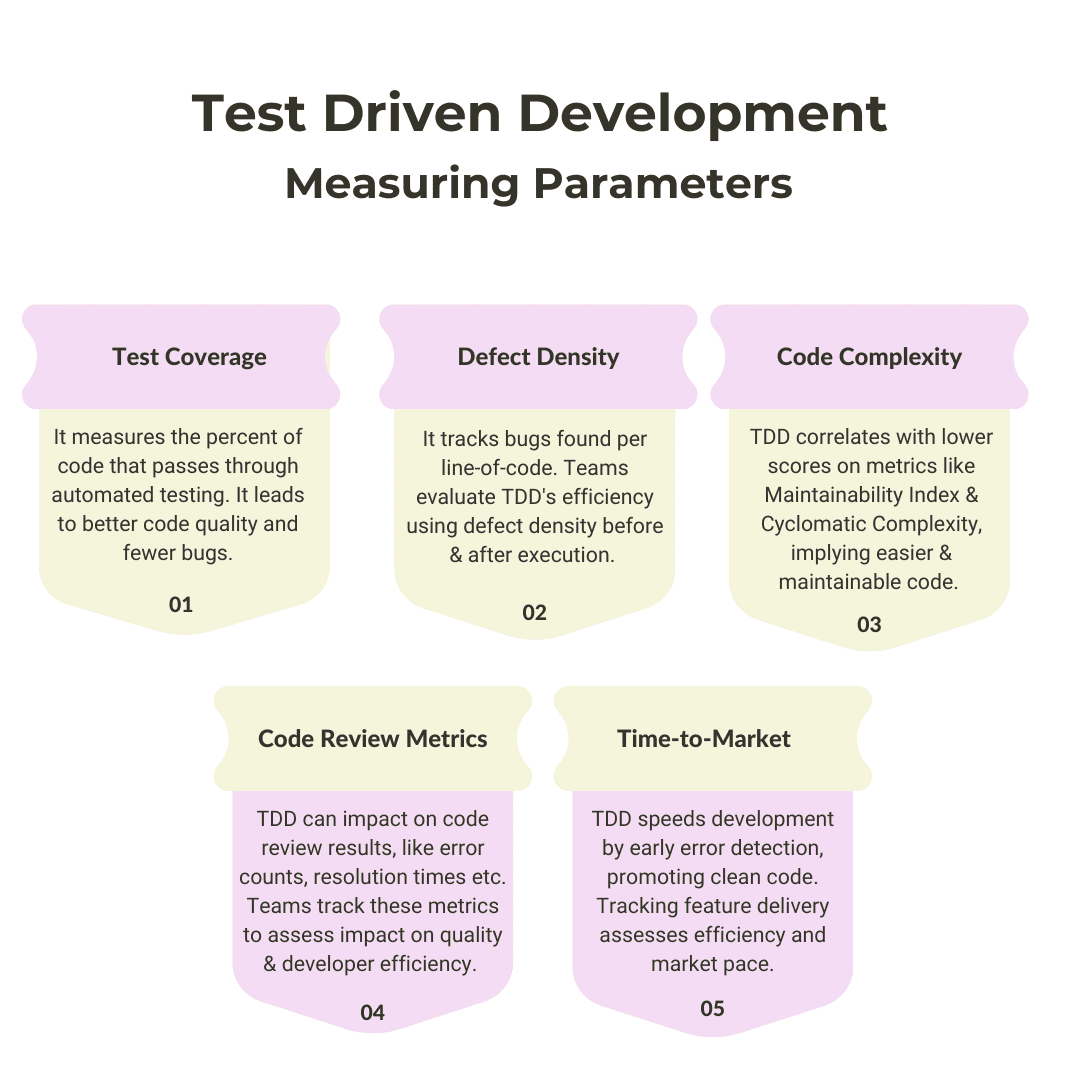Test driven development (TDD) plays a crucial role in agile development. It is an important foundation in the drive to produce excellent software. Since code quality impacts an application’s scalability, maintainability, and stability, it is one of the most significant factors in software development. One can’t emphasize the significance of code quality since it guarantees that software fulfills functional requirements, runs smoothly, and is flexible enough to adapt to evolving requirements. Developers frequently find it difficult to maintain good code quality due to tight deadlines, changing requirements, and the need to deliver features swiftly. Complex requirements, technical debt, and the requirement to strike a balance between speed and exhaustive testing and review procedures increase these difficulties.
Test-driven development (TDD) is one of the most effective techniques for continuously enhancing code quality. The TDD cycle can be concisely summarized as “Red, Green, Refactor.” This approach involves writing failing tests (red), writing the minimum code to pass the tests (green), and then enhancing the code (refactor). Developers may concentrate on defining clear requirements and modular, tested code from the very beginning by following this methodical approach. TDD encourages developers to adopt an approach that puts code reliability and quality over rapid feature development. This strategy encourages a spirit of teamwork among development teams and strives for continuous improvement. It leaves little scope for errors, ensuring an enhancement in maintainability.
Furthermore, TDD and Agile approaches have a mutually beneficial connection, as TDD supports agile principles like iterative development, constant feedback, and incremental value delivery to clients. Agile approaches like Scrum and Kanban provide adaptable planning, change response, and regular product delivery and blend in perfectly with TDD. Teams can ensure that code quality is a top priority throughout the development lifecycle by including TDD into Agile processes. This enables teams to meet customer requirements efficiently and successfully adjust to changing requirements and market demands.
The Role of Test Driven Development in Agile Development
TDD complements Agile by supporting constant feedback and iterative development. Developers build tests before implementing code to make sure it complies with client requirements and to help identify errors early on. This iterative methodology enables agile teams to respond quickly to changing requirements and develop effective software. TDD promotes cooperation and communication within Agile teams by providing a common framework for specifying requirements, verifying implementation, and addressing feedback. This collaborative technique encourages alignment with project goals and cultivates team spirit in agile development environments.
Agile and Test Driven Development (TDD) approaches both prioritize continual progress through an iterative methodology. Writing failed tests, putting the code in place to pass them, and then refactoring for better design is the cycle of TDD. Similarly, agile approaches support iterative development through the use of brief development cycles called sprints. These sprints enable the regular delivery of functional software. Its iterative structure encourages continuous input, allowing teams to identify problem areas, modify plans as necessary, and strive for small improvements in the software product and development process.
TDD promotes Agile concepts by emphasizing adaptable planning, quick delivery, and constant feedback. Test-driven development (TDD) keeps development aligned with evolving requirements by requiring teams to write tests before writing code. This enables teams to make necessary changes in plans in real time based on testing and feedback from stakeholders. Because TDD follows an incremental approach to development, it supports the early delivery of functional software, which enables teams to validate features and get user feedback sooner. Moreover, TDD promotes on-going feedback loops by instantly validating changes, fostering collaboration among developers, testers, and stakeholders, and enabling teams to promptly improve the responsiveness and quality of the software they’re developing.
TDD improves cooperation and communication within Agile teams through the development of a shared understanding of requirements and promoting transparency throughout the development process. Its basic line of action is to put tests into writing first and make developers and testers work together. This gives an idea of the final outcome of the product in real time. TDD also encourages regular communication among team members as they work jointly to develop tests, implement code into execution, and analyze outcomes.
As one and one makes eleven, similarly in Agile development settings, this collaborative approach promotes the sharing of information, fosters trust among team members, reduces miscommunications, and ultimately leads to more effective problem-solving and superior software outcomes.
Implementing Test Driven Development in Agile Projects
To use Test-Driven Development (TDD) in Agile projects, TDD methods must be easily integrated into the methodology of Agile development. In most cases, the process begins with the development of user stories and acceptance criteria in collaboration with stakeholders. Then, using these criteria, developers write failed unit tests that explain the code’s expected behavior. Next, they develop the bare minimum of code required to pass the failed tests while strongly adhering to the requirements specified in user stories. Once the code passes the tests, developers refine it as necessary to improve design and readability while ensuring functionality remains intact.

Unit tests are continually run throughout this process using automated testing frameworks, which give immediate feedback on the accuracy of the code. As part of the build process, test suites are regularly executed to ensure that any changes made to the codebase don’t cause regressions or interfere with already-existing functionality. As they collaborate to define requirements, check implementation, and handle feedback, developers, testers, and stakeholders are encouraged to work together in an iterative manner. Teams can deliver high-quality, functional applications gradually, modify plans dynamically, and successfully respond to changing needs and customer needs by implementing TDD inside Agile projects.
Measuring Success and Continuous Improvement
Test Driven Development (TDD) approaches have an impact on software development processes and outcomes; thus, suitable metrics and Key Performance Indicators (KPIs) are necessary to assess how well TDD is increasing code quality.

Test Coverage:
This measures the percent of code that passes through automated testing. Higher test coverage indicates more codebase components are being tested. It leads to better code quality and fewer bugs. TDD usually produces good test coverage as developers write tests before implementing code.
Defect Density:
This measures the overall number of issues found per unit of code. Teams are able to evaluate the effectiveness of TDD in reducing the number of defects in the codebase by comparing the defect density before and after the technique is used.
Code Complexity:
Metrics like the Maintainability Index or Cyclomatic Complexity can evaluate the complexity of the codebase. Applying TDD practices is directly proportional to lower complexity scores. Lower complexity scores mean code is simpler and more maintainable.
Code Review Metrics:
TDD may influence code review results, such as the number of errors found, the time it takes to fix them, and the overall quality of submitted code. Teams can monitor these metrics to review the impact of TDD on code quality and developer productivity.
Time-to-Market:
Test Driven Development can result in quicker development cycles by identifying errors early on and encouraging cleaner, more maintainable code. Tracking the time taken to deliver a new feature or release helps in determining the contribution of technology-driven development (TDO) to improving efficiency and a faster time to market.
By monitoring these metrics and KPIs, teams can assess the effectiveness of TDD in improving code quality, reducing defects, enhancing developer productivity, and ultimately delivering higher-quality software within Agile projects.
Teams may evaluate the effectiveness of Test Driven Development in improving code quality, decreasing defects, and increasing developer productivity. This evaluation ultimately produces higher-quality software within Agile projects. Teams may constantly enhance their Test-Driven Development (TDD) procedures and adjust to changing project demands by encouraging a culture of reflection, experimentation, and cooperation. Regular meetings and discussions help teams identify areas for improvement in their test-driven development (TDD) process, such as enhancing test coverage, optimizing test design, or accelerating test execution.
Conclusion
Test Driven Development (TDD) plays a crucial role in enhancing code quality within agile development environments. By prioritizing testing and iterative development, TDD promotes cleaner, more maintainable code, reduces defects, and fosters a culture of collaboration and continuous improvement. Through its alignment with Agile principles such as adaptive planning, early delivery, and continuous feedback, TDD enables teams to deliver high-quality software that meets customer needs efficiently and effectively adapts to changing requirements.
By embracing TDD practices, Agile teams can boost code quality, enhance productivity, and ultimately deliver value to stakeholders while maintaining a competitive edge in today’s dynamic software development landscape.



